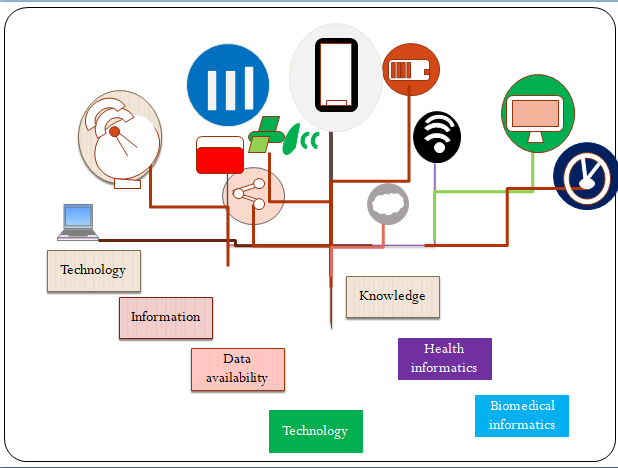Data and Informatics Technology
Data and Informatics Technology is the technology part of collecting data and setting it into a program. It includes computer systems, software systems, programming systems. Various types of designing to compile and collect this data and deliver it to the users.
Basic concept of Data and Informatics Technology
Data and Informatics Technology is the use of scientific knowledge for practical purposes or applications, whether in industry or in any aspect of our daily life. So, basically, whenever we use our scientific knowledge to achieve a particular goal, we do good research through technology, for example, computers, mobiles, and software collects its data. Various forms of communication convey or describe facts, thoughts, or data, with the most important being the invention of the computer and mobile phone, their first commercial application, and the diffusion of technologies, which distinguish between large-scale replication and growth. Are Introduces the technology life cycle as a simple conceptual model.
Role of data and information
Data consists of raw, unprocessed facts, organizing the data and programming it into a system and then giving it a good structure with more information and more research, while information is the data. is processed, organized and interpreted to add meaning and value. This explanation sets the stage for how businesses can turn data into strategic assets through effective knowledge management.
Example:-
A list of temperatures, a paragraph of text, a photo file, or a song is all forms of data.
1 Monthly bills of a person
2 Number of students in a class
3 Number of persons liking a particular food
Difference between date and informatics
- Quantitative
- Qualitative
Quantitative
Quantitative data refers to numerical data, such as user performance metrics or feedback ratings. It is used to assess UX achievements and monitor how well they are moving towards UX goals against specified levels. Quantitative analysis and research is the process of collecting and examining measurable and verifiable data such as revenues, market share, and wages to understand worker behavior and performance. Used at business level.
Qualitative
Qualitative data is information that cannot be easily expressed by counting, counting, or using numbers. It is collected from text, audio and images and data is shared through data visualization tools, such as word clouds, timelines, graph databases, concept maps and info graphics, and can be explored by users through software.
Principles of informatics
Confidentiality, intergrty and availability.
Key component
Date management
In data management we organize the information according to a system then store it and give it a new form. Warehousing, and cloud computing are central to this aspect.
Data Analytics
Data analysis focuses on the process of examining past data through business understanding, data understanding, data preparation, modeling and evaluation, and deployment. It is a subset of data analytics, which requires the process of analyzing multiple data to focus on why something happened and what might happen in the future based on past data. . Making decisions and storing them according to the computer system.
- Descriptive Analytics
- Diagnostic Analytics
- Predictive Analytics
- Prescriptive Analytics
Bioinformatics
Classic data from bioinformatics include DNA sequences of genes or complete genomes. The amino acid sequence of proteins; and the three-dimensional structures of proteins, nucleic acids and protein–nucleic acid complexes, including calcium, proteins, carbohydrates, cheese, etc.
Health Informatics
Health informatics is the study and implementation of computer structures and encyclopedia newspapers books oxford dictionaries algorithms to improve the communication, understanding and management of medical information. It can be seen as a branch of engineering and applied science.
Business Informatics
Business Informatics (BI) is a field combining concepts from economics, economics of digitization, administration, accounting, internal auditing, Informatics Technology and computer science. Informatics centers around creating a framework of programming and tools that ultimately provide the organization with efficient operations based on information technology applications. The focus on programming and tools increases the value of economics and information technology analysis and the use of it by users in developing projects and business programs that use the analytics and information gathered by computers.
- Big Data
- Artificial Intelligence (AI) and Machine Learning (ML)
- Data Security and Privacy
Common Applications
Healthcare
Health informatics is the study and implementation of computer architectures and algorithms to improve the communication, understanding, and management of medical information. It can be seen as a branch of engineering and applied science. Health informatics is a spectrum of multidisciplinary fields that includes the study of the design, development, and application of computational innovations to improve health care. Especially computer engineering, software engineering, information engineering, bioinformatics, bio-inspired computing, theoretical computer science, information systems, data science, Data and Informatics Technology, autonomic computing, and behavioral informatics.
Business Intelligence (BI)
Business intelligence includes data analytics and business analytics, but they are used only as parts of the whole process. BI helps users draw conclusions from data analysis. Data scientists dig into the details of data using advanced statistics and predictive analytics to discover patterns and predict future patterns, working on top of more research and information findings. The design helps and users design a new program based on the research done.
Financial Services
With digital payments, online banking, analytics and reporting, banks (or other institutions) can now create much better investment opportunities for everyone. They know exactly how much money we have, what we spend, and the risks we take.
360WebSol






Leave a Reply